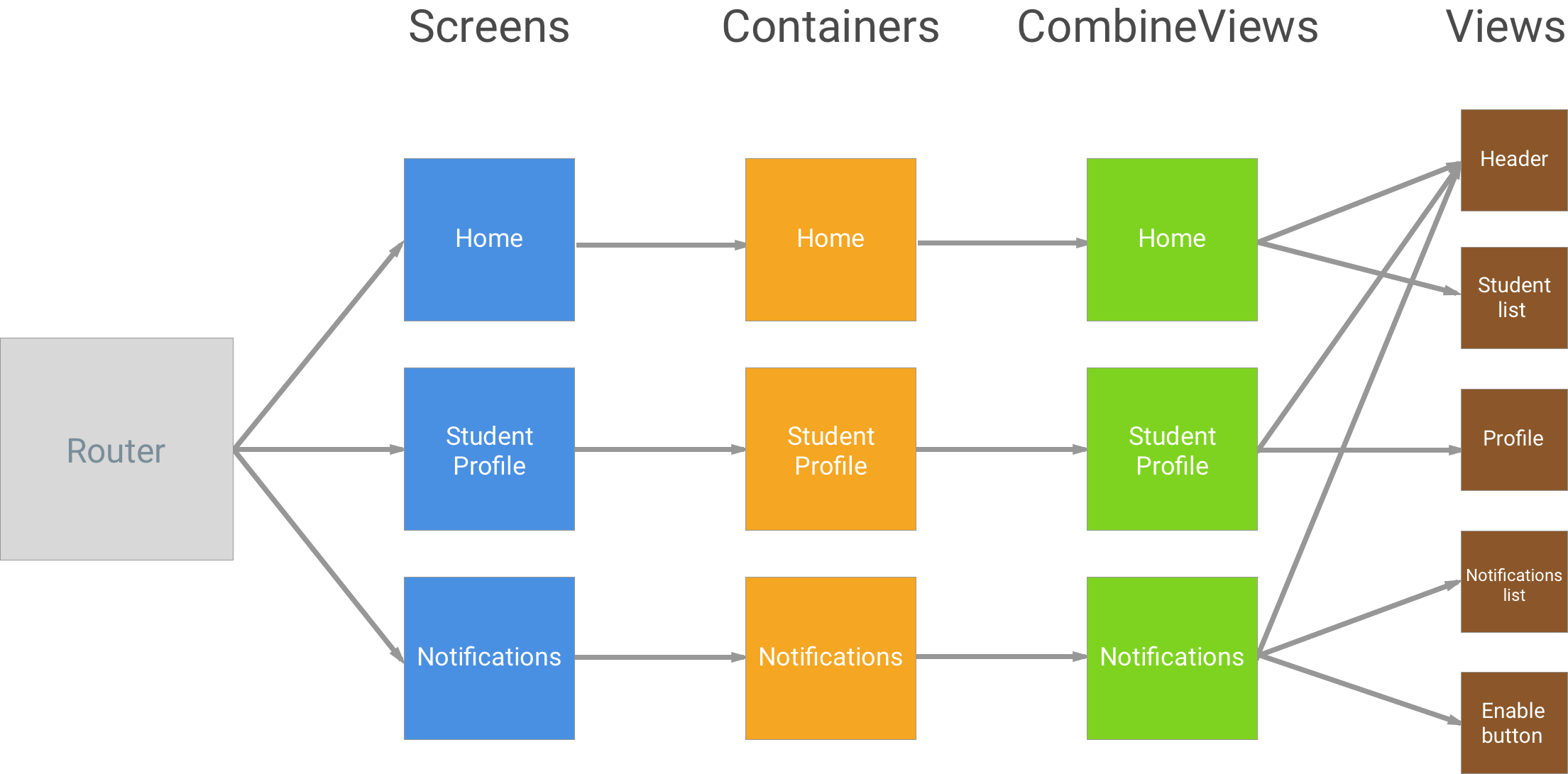
One of the problems that
A small disclaimer, that it’s a result of experience we got in the team which includes only web developers asking for some help from a true mobile department.
We divided our components into several layers to achieve a better understanding of what part of business logic should go where:
Let’s talk about this layers closely one by step.
A screen is a component which is rendered by router. It’s responsible for the following tasks:
Take a look at this code snippet of the screen’s code arrangement we use:
import Home from 'src/containers/Home'
class HomeScreen extends React.Component {
render = () => pug`
Home(
userId=this.userId()
goToSettings=this.goToSettings
goToNotifications=this.goToNotifications
goToStudentProfile=this.goToStudentProfile
)
`
userId = () =>
this.props.navigation.state.params.id
goToSettings = () =>
this.props.navigation.navigate('Settings')
goToNotifications = () =>
this.props.navigation.navigate('Notifications')
goToStudentProfile = (id, studentName) =>
this.props.navigation.navigate('StudentProfile', { id, title: studentName })
}Pay attention to the importing of the Home container, defining the `goTo` methods to use it inside a View component reacting of clicks, grabbing an id from params.
Go further!
The layer of containers is a data boss: grabbing data from the store, transforming it to more suitable for a view shape, storing some minor state which is dedicated only for this part of the app like shouldShowModal.
It’s better to have a real example of using such component. Take a look at the container organizing we’ve got in our projects:
import React from 'react'
import { connect } from 'react-redux'
import Home from 'src/components/Home'
import { denormalizeStudents } from 'src/models/Students/normalizer'
const mapStateToProps = ({ students }) => {
const result = denormalizeStudentData(
students.list,
students.entities,
)
return { students: result }
}
const mapDispatchToProps = {
startFetchData: actions.startFetchData.init,
}
class HomeContainer extends Component {
state = {
shouldShowModal: false,
}
componentDidMount() {
this.props.startFetchData()
}
render = () => pug`
Home(
shouldShowModal=this.state.shouldShowModal
students=this.props.students
goToSettings=this.props.goToSettings
goToNotifications=this.props.goToNotifications
goToStudentProfile=this.props.goToStudentProfile
)
`
}
export default connect(
mapStateToProps,
mapDispatchToProps
)(HomeContainer)Here you can notice the using of denormalization. It’s a part of the data transforming process (also a small teaser for the next post 😉 )
It a connector of the worlds of data and UI: it gets the props from a container and distributes it across small UI components – Views. Check out the example of a
class Home extends React.Component {
render = () => pug`
Content
Header(
goToSettings=this.props.goToSettings
goToNotifications=this.props.goToNotifications
)
StudentList(
data=this.props.students
onStudentClick=this.props.goToStudentProfile
)
`
}And it’s enough. Of course, you can store here a state which doesn’t affect other parts of the app, like isModalOpened, etc. Be wise 😎
Aaaaand views – working staff of your app. Views are small parts which we use to build up the app – buttons, checkboxes, headers, etc. And I’d like to say the following: keep it as simple as possible. You can achieve it by passing as simple props as you can (a string, not an object i.e), reducing the state and the size of such components. It gives you an ability to reuse your code by constructing a big component from the small ones.
That’s it 🙂
To understand the whole picture of how we create React Native apps using our project architecture take a look at the following schema of a sample pet app:

The approach of arranging business logic helps us to clearly know what goes where not polluting containers or simple views with state and methods. Piece!
It’d be great to look at your ideas, so that go ahead and share your thoughts about approaches how the community can do better React Native apps.
Happy coding!
Check out our newsletter